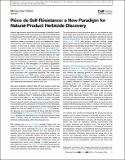| dc.contributor.author | Hill, Matthew | |
| dc.contributor.author | Weng, Jing-Ke | |
| dc.date.accessioned | 2020-04-14T16:49:03Z | |
| dc.date.available | 2020-04-14T16:49:03Z | |
| dc.date.issued | 2018-09 | |
| dc.identifier.issn | 1674-2052 | |
| dc.identifier.uri | https://hdl.handle.net/1721.1/124628 | |
| dc.description.abstract | Modern agriculture is faced with the challenge of feeding a rapidly growing population.While crop yields have risen dramatically since the beginning of the twentieth century, increasing demand for foodthreatens to outstrip the pace of agricultural progress. While significant research continues to focus on strategies that directlymaximize crop yield, another important research area is the minimization of yield loss to weeds, insects, diseases, and abiotic stresses. Crop yield losses due to weeds can reach above 34%,the highest potential loss of any biotic factor (Oerke, 2006). The use of herbicide-resistant crops is an important tactic for effective lyminimizing these losses. However, continued reliance on major herbicide-resistant traits has resulted in issues that threaten to under mine the effectiveness of the technique. In particular, the popularity and dominance of glyphosate-resistant ‘‘Roundup Ready’’crops have led to the emergence of numerous glyphosate-resistant weed species (Heap, 2014), wide spread environmental contamination with glyphosate and its major degradation product (Battaglin et al., 2014), and public concerns about health risks associated with glyphosate exposure. The other major herbicide-resistant trait, BAR, which confers glufosinate resistance,was recently shown to exhibit off-target effects onplant metabolomes (Christ et al., 2017), raising the urgency to develop newand better herbicide-resistant traits for crop use. | en_US |
| dc.description.sponsorship | National Science Foundation (U.S.) (Grant CHE-1709616) | en_US |
| dc.language.iso | en | |
| dc.publisher | Elsevier BV | en_US |
| dc.relation.isversionof | 10.1016/j.molp.2018.08.002 | en_US |
| dc.rights | Creative Commons Attribution-NonCommercial-NoDerivs License | en_US |
| dc.rights.uri | http://creativecommons.org/licenses/by-nc-nd/4.0/ | en_US |
| dc.source | Other repository | en_US |
| dc.subject | Plant Science | en_US |
| dc.subject | Molecular Biology | en_US |
| dc.title | Pièce de Self-Résistance: a New Paradigm for Natural-Product Herbicide Discovery | en_US |
| dc.type | Article | en_US |
| dc.identifier.citation | Hill, Matthew and Jing-Ke Weng. "Pièce de Self-Résistance: a New Paradigm for Natural-Product Herbicide Discovery." Molecular plant 11 (2018): 1115-1116 © 2019 The Author(s) | en_US |
| dc.contributor.department | Massachusetts Institute of Technology. Department of Biology | en_US |
| dc.relation.journal | Molecular plant | en_US |
| dc.eprint.version | Author's final manuscript | en_US |
| dc.type.uri | http://purl.org/eprint/type/JournalArticle | en_US |
| eprint.status | http://purl.org/eprint/status/PeerReviewed | en_US |
| dc.date.updated | 2020-02-03T17:49:30Z | |
| dspace.date.submission | 2020-02-03T17:49:32Z | |
| mit.journal.volume | 11 | en_US |
| mit.journal.issue | 9 | en_US |
| mit.license | PUBLISHER_CC | |
| mit.metadata.status | Complete | |
